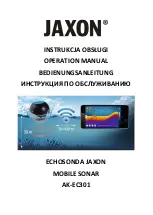
Signal Interpretation
Hard-bottom readings (rock or gravel) will be displayed by a wide
band of RED light indicating a strong return signal. Conversely, a
soft bottom (mud or silt) will return a weaker signal and will result
in a narrower RED band or possibly even a combined RED and
ORANGE band. A soft bottom with weed growth will often
appear as a narrow RED or ORANGE band combined with both
solid and broken YELLOW segments indicating weeds. Any fish
in the weeds may show as RED or ORANGE depending on fish
size and relationship within the transmit beam (in the middle or
on the outside of the transmit signal).
Reading Bottom -
In interpreting depth, always read the leading
edge (shallowest side) of the signal return. If you have a strong
signal return (wide band of RED light) and it starts at 13 feet and
ends at 16 feet, the correct depth is 13 feet or the shallowest
leading edge of the return signal. Anything beyond the shallow-
est leading edge indicates the strength of the return signal.
Reading Fish -
Fish will generally appear as separate targets
from the bottom. A fish target can be displayed as either RED,
ORANGE or YELLOW, depending on the size of the fish and the
location within the transmit beam. Larger fish located in the cen-
ter of the beam (cone) can appear RED and will be displayed as
a wider band on the display. Smaller fish or fish on the outside of
the cone may appear ORANGE or even YELLOW. Fish moving
through the transmit beam may change color as the return signal
strengthens or weakens reflecting their location. Fish that are
right on the bottom can appear as part of the bottom. The best
indication of a fish sitting right on the bottom is that the leading
edge of the bottom return signal is either ORANGE or possibly a
dithering or flickering RED segment. It is important that the GAIN
or sensitivity be kept to a minimum when displaying a strong
bottom return. Too much GAIN will flood out the ability to
differentiate targets and clutter the display.
Reading Lures or Bait -
The LX-3 will pick up and display small
objects like lures or bait. When tuning the unit to display your
lure or bait, lower the object to the desired depth and turn up the
GAIN until you see the lure or bait on the display. It is important
that the GAIN be set so it displays the lure or bait as you raise or
lower it. CAUTION: Too much GAIN will cause clutter and may
make it difficult to distinguish other targets like fish near the
bottom. When tuning the unit to display lures or bait, make sure
that the objects are in the center of the hole and therefore in the
center of the transmit beam. If there’s water current (some lakes
have underwater current or movement) and the lure doesn’t
weigh much, it may move to the outer edge of the signal or out
of the transmit beam altogether. This will make it difficult or
impossible to pick it up on the display.
Dead Zone -
All sonar units will have a dead zone in certain
circumstances. This occurs on sharp drop-offs where the
transmit beam (cone) hits the shallower edge of the drop-off and
returns before the deeper edge returns. This in effect creates an
area undisplayed between the shallower and deeper water within
the transmit beam.
User Tips
Reading Through Ice -
The LX-3 will provide accurate informa-
tion reading through ice providing the ice is reasonably clear. Ice
that appears milky or full of air bubbles will make it difficult or
impossible to get an accurate reading. To send and receive the
best signal, wet the ice with water to improve the coupling of the
transducer to the ice. Please do not use anti-freeze or windshield
washer fluid, because it pollutes the environment. Bottom can be
easily be determined without drilling holes, therefore greatly
reducing time and energy in locating your fishing spot.
Fine Tuning Gain Control -
To adjust GAIN properly, lower your
lure or bait to within a foot of the bottom. Turn the GAIN up or
down until the lure or bait shows as a steady yellow light. You
should be able to raise or lower the lure in a jigging fashion
without loosing the signal. If the GAIN (or sensitivity) is kept to a
minimum, you should be able to separate targets down to 2.15
inches on the 20-foot scale. You may need to fine tune the GAIN
12
13
Summary of Contents for LX-3
Page 1: ...USER MANUAL 3 COLOR SONAR ICE SYSTEM 3 COLOR SONAR SYSTEM ...
Page 6: ......
Page 11: ......
















